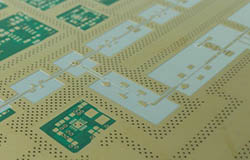When the signal rate reaches a certain level, different PCB board materials need to be selected according to requirements to control signal loss.
There are many kinds of high-speed PCB materials, such as Rogers, Taconic, Polyclad, Park Nelco, and TUC; different PCB materials have different dielectric constants and dissipation factors. The Dk (dielectric constant) and Df (dissipation factor) of the plate have a greater impact on high-speed signals.

Permittivity refers to the ratio of the original applied electric field to the electric field in the final medium that will generate induced charges and weaken the electric field when an electric field is applied. The dielectric constant can also be said to be the capacitance. When the capacitance of the multi-layer insulation board is large, it means that a lot of the transmission energy in the signal line is stored in the board, and it can also be said that part of the transmission energy is wasted in the dielectric material. When the dielectric constant is too large, the signal propagation rate will slow down. Therefore, the greater the number of dielectric electric fields, the greater the propagation delay and the slower the signal propagation speed. In the selection of PCB board materials, a board with a smaller dielectric constant should be used as much as possible to reduce the propagation delay and at the same time reduce the dielectric loss.
The dissipation factor refers to the ratio of the energy in the signal line that has been leaked into the insulating PCB material to the energy in the existing signal line. The greater the dissipation factor of the PCB substrate, the greater the loss of wavelength absorbed by the dielectric layer. This relationship is more obvious under the high-frequency line. It directly affects the efficiency of high-frequency signal propagation. For PCB, the faster the signal rate, the greater the proportion of signal loss in the substrate. In order to achieve the purpose of high-speed signal propagation, the use of materials with low dissipation factors is becoming more and more important in high frequencies.
The energy loss of high-frequency signals in the transmission process is divided into three types: dielectric loss, conductor loss (heating, skin effect), and radiation loss. The reduction of the dielectric loss is generally by choosing a lower Df value of the plate; the reduction of the conductor loss is generally by changing the flatness of the copper foil and widening the trace. The higher the signal frequency, the more obvious the skin effect, so the surface of the signal transmission conductor is more obvious. The flatter the better, try not to use rough copper foil; and the radiation loss is generally solved by shielding.